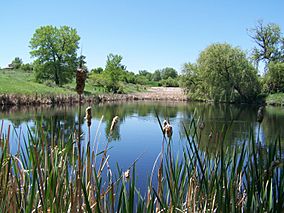Two Ponds National Wildlife Refuge facts for kids
Quick facts for kids Two Ponds National Wildlife Refuge |
|
|---|---|
|
IUCN Category IV (Habitat/Species Management Area)
|
|
 |
|
| Location | 9210 W 80th Avenue, Arvada, Colorado (located in Jefferson County, Colorado, United States) |
| Area | 72.2 acres (29.2 ha) |
| Established | 1992 |
| Governing body | U.S. Fish and Wildlife Service |
| Website | Two Ponds National Wildlife Refuge |
Two Ponds National Wildlife Refuge is a special place in Arvada, Colorado. It's a small wildlife refuge, meaning it's a protected area for animals and plants. This refuge is part of the larger National Wildlife Refuge System in the United States. It's unique because it's the smallest "urban unit" in this system, which means it's right inside a city!
The refuge covers about 72.2 acres (which is about 29 hectares) of land. This includes 63.2 acres (25.6 hectares) of higher, dry land called uplands. It also has 9.0 acres (3.6 hectares) of wetlands, which are areas where the land is often wet, like marshes. Plus, there are three small ponds.
This important natural area is located in Jefferson County, Colorado, near the big Denver Metropolitan Area. It was saved from being built over in 1990 by a group of people who cared about nature. This group is now called the Two Ponds Preservation Foundation. The refuge officially started in 1992. It helps protect many different animals and special plants that grow in the high prairie. Visitors can enjoy activities like hiking, guided tours, and educational programs.
Contents
What is a National Wildlife Refuge?
A National Wildlife Refuge is a protected area set aside by the United States government. Its main goal is to protect wild animals and their homes. These refuges help make sure that different kinds of wildlife have safe places to live and thrive.
Why is Two Ponds Special?
Two Ponds is special because it's an "urban refuge." This means it's located right in the middle of a city, not far away in the wilderness. It gives city residents a chance to connect with nature. It also provides a safe haven for wildlife in an area where cities are growing.
History of Two Ponds Refuge
In the late 1980s, the land where Two Ponds is now was going to be developed. This meant buildings might be put there. But a group of local citizens wanted to save this natural space. They worked hard to protect it.
How it Was Saved
These concerned citizens formed a group called the Two Ponds Preservation Foundation. They worked with the United States Fish and Wildlife Service. Together, they managed to get the land protected. This effort led to the refuge being established in 1992. It shows how people can make a difference in protecting nature.
Animals and Plants at Two Ponds
Two Ponds National Wildlife Refuge is home to many different kinds of wildlife. You can find various birds, mammals, reptiles, and amphibians here. It also protects unique plants that are native to the high prairie environment.
Wildlife You Might See
- Birds: Many types of birds visit or live at the refuge. You might spot ducks, geese, and other water birds around the ponds. Songbirds and birds of prey also use the area.
- Mammals: Small mammals like rabbits, prairie dogs, and sometimes even foxes can be seen.
- Reptiles and Amphibians: Frogs, toads, and different kinds of snakes live in the wetlands and uplands.
Unique Plants
The refuge protects plants that are important to the local ecosystem. These plants provide food and shelter for the animals. They are part of the original high prairie landscape that once covered much of Colorado.
Things to Do at the Refuge
Two Ponds National Wildlife Refuge offers several activities for visitors. It's a great place to learn about nature and enjoy the outdoors.
Exploring the Trails
There are trails for hiking that let you walk through different parts of the refuge. These trails are a good way to see the ponds, wetlands, and uplands. You can observe wildlife in their natural homes.
Learning Opportunities
The refuge offers guided tours. These tours are led by experts who can teach you about the animals and plants. There are also educational programs for groups. These programs help people of all ages learn about conservation and the environment.


